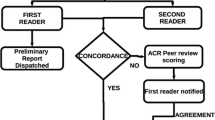Abstract
The study aims to prove that it takes less time to look up relevant clinical history from an electronic medical record (EMR) if the information is already provided in a specific space in the EMR by a fellow radiologist. Patients with complex oncological and surgical histories need frequent imaging, and every time a radiologist may spend a significant amount of time looking up the same clinical information as their peers. In collaboration with ACMIO and Radiant Epic team, a space labeled “Specialty Comments” was added to the SNAPSHOT of patient's chart in EMR. For our research purpose, the specialty comment was labeled as boxed history as a variable for data analysis. If the history was not provided in that particular space, it was labeled as without boxed history. Inclusion criteria included outpatients with complex oncological histories undergoing CT chest, abdomen, and pelvis with IV contrast. The time to look up history (LUT) was documented in minutes and seconds. Two assistant professors from Abdominal Imaging provided LUT. A total of 85 cases were included in the study, 39 with boxed history and 46 without boxed history. Comparing averages of the individual reader means for history, mean LUT differed by 2.03 min (without boxed history) versus 0.57 min (with boxed history), p < 0.0001. The t-test and the nonparametric Wilcoxon tests for a difference in the population means were highly significant (p < 0.0001). A history directed to radiologist's needs resulted in a statistically significant decrease in time spent by interpreting radiologists to look through the electronic medical records for patients with complex oncological histories. Availability of history pertinent to radiology has wide-ranging advantages, including quality reporting, decrease in turnaround time, reduction in interpretation errors, and radiologists’ continued learning. The space for documenting clinical history may be reproduced, or some similar area may be developed by optimizing the electronic medical records.





Similar content being viewed by others
Data Availability
The author(s) declare(s) that they had full access to all of the data in this study and the author(s) take(s) complete responsibility for the integrity of the data and the accuracy of the data analysis.
References
Larson DB, Durand DJ, Siegal DS. Understanding and applying the concept of value creation in radiology. Journal of the American College of Radiology 2017;14:549-557
Gunderman RB, Phillips MD, Cohen MD. Improving clinical histories on radiology requisitions. Academic radiology 2001;8:299-303
Armstrong 2nd J. Morality, ethics, and radiologists' responsibilities. AJR American journal of roentgenology 1999;173:279-284
Loy CT, Irwig L. Accuracy of diagnostic tests read with and without clinical information: a systematic review. Jama 2004;292:1602-1609
Reiner BI, Krupinski E. The insidious problem of fatigue in medical imaging practice. Journal of digital imaging 2012;25:3-6
Schemmel A, Lee M, Hanley T, et al. Radiology workflow disruptors: a detailed analysis. Journal of the American College of Radiology 2016;13:1210-1214
Waite S, Scott J, Gale B, et al. Interpretive error in radiology. American Journal of Roentgenology 2017;208:739-749
Fitzgerald R. Error in radiology. Clinical radiology 2001;56:938-946
Bowman C, Ambrosini V. Value creation versus value capture: towards a coherent definition of value in strategy. British journal of management 2000;11:1-15
Doshi AM, Moore WH, Kim DC, et al. Informatics solutions for driving an effective and efficient radiology practice. RadioGraphics 2018;38:1810-1822
Author information
Authors and Affiliations
Corresponding author
Ethics declarations
Conflict of Interest
The authors declare no financial disclosure. An abbreviated version of this study in PowerPoint format was presented as Quality Improvement report QI103-ED-X at RSNA 2020- 106th Scientific Assembly and Annual Meeting, November 29 to December 5, 2020.
Additional information
Publisher's Note
Springer Nature remains neutral with regard to jurisdictional claims in published maps and institutional affiliations.
Rights and permissions
Springer Nature or its licensor (e.g. a society or other partner) holds exclusive rights to this article under a publishing agreement with the author(s) or other rightsholder(s); author self-archiving of the accepted manuscript version of this article is solely governed by the terms of such publishing agreement and applicable law.
About this article
Cite this article
Shafique, U., Hillis, S.L., Park, J.M. et al. Radiologists Help Each Other to Improve Efficiency by Decreasing the Time to Look Up a Patient’s Relevant Clinical History in the Electronic Medical Record. J Digit Imaging 36, 388–394 (2023). https://doi.org/10.1007/s10278-022-00726-4
Received:
Revised:
Accepted:
Published:
Issue Date:
DOI: https://doi.org/10.1007/s10278-022-00726-4




